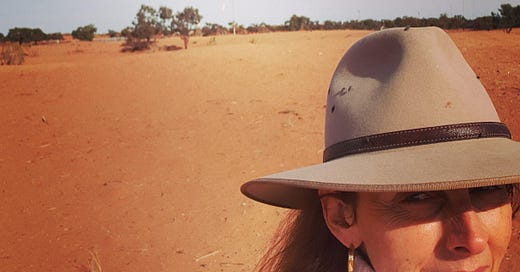The naming of Australia's Strzelecki Desert.
And tasting wind blown salt on my tongue while on a research trip to the area.
It’s said that everything and everyone is interconnected in some way. I often find when I’m sleuthing for facts that some snippet of information will pop up and I’m left pondering the events that link people and places together. This happened about seven years ago - yes, it’s been a minute, but stories bubble to the surface when the mood strikes and it’s a Sunday afternoon in the northwest plains where I live and the temperature gauge is cracking 36 degrees - but back to my story. Seven years ago I was reading up on the Strzelecki Desert. I’d been side-tracked (which easily happens as you can see) from learning about the desert environment in preparation for a field trip to the area, by an article on Sir Paweł Edmund Strzelecki.
(That’s me in the Strzelecki Desert. It was winter, but no one told me the flies. The wind sock in the distance marks a strip used by The Royal Flying Doctor Service near to the station where I stayed.)
Strzelecki was of polish nobility and self-taught in the art of soil science and mineralogy. After time spent in France and New York’s farming regions, where he analyzed soils and the gluten content of wheat -among other things, wanderlust took hold. In the mid-1830s he travelled extensively to Chile, Cuba, Tahiti, the South Sea Islands, and New Zealand before arriving in Sydney in the April of 1839.
He was quick to make his mark in history. Befriending James Macarthur at Camden Farm, Strzelecki along with Macarthur, James Riley and two Aboriginal guides explored the Snowy Mountains. Strzelecki climbed and named Australia’s highest mountain, Mount Kosciuszko, after Tadeusz Kościuszko, one of the national heroes of Poland and a hero of the American Revolutionary War. The Gippsland region of Victoria was next in Strzelecki’s sights. He explored the area naming it after the governor of the day, with the Strzelecki Ranges a set of low mountain ridges located in West Gippsland eventually being named in his honor.
But exploring however isn’t for the faint-hearted and Strzelecki and his team found the going tough. The party would have starved to death were it not for their Aboriginal guide Charley Tarra whose knowledge saved them from certain disaster.
(The Strzelecki Track)
Strzelecki then explored the whole of Tasmania from 1840 to 1842 with the help of three men and two pack horses before arriving in Sydney by steamer in the October of 1842. NSW was next in his sights and he headed to the northwest of the state collecting specimens along the way. By the time he left Sydney the following year he’d travelled 11,000 kilometers (7,000 miles) through New South Wales, Victoria and Tasmania, examining the geology along the way. The Strzelecki Desert and Track are named in his honor.
For those of you who have read my novel The Cedar Tree you’ll be aware of the Irish thread in the narrative and of course part of the novel is set smack in the middle of the Strzelecki Desert. Which is why I found it interesting to learn that Strzelecki was placed in charge of dispensing funds on behalf of a private charity called the “British Relief Association” for people in Ireland affected by the great famine. Strzelecki developed an excellent method of helping the starving by feeding children directly through the schools. He also assisted Irish families emigrating to Australia and in 1854 became Chairman of the Family Colonisation Loan Society, originated by Caroline Chisholm. He led an extraordinary life, one intimately tied to Australia.
I spent five days in the Strzelecki Desert on the NSW / South Australian border. A region where the light glitters across the land and the westerly winds blew from the central desert regions leaving the taste of salt on my tongue. It was beautiful in its desolation, windy, ever-changing and strangely magnetic. A research trip worthy of another post.
Sir Paweł Edmund Strzelecki explorer, geologist, philanthropist.(1797 – October 1873).








Extremely interesting story thanks for all your writings cheers Artie